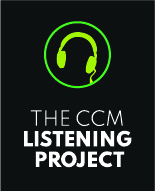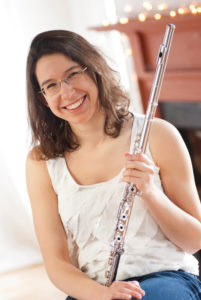
Rachel Sumner, Concert & Masterclass, Saturday, March 12
Singer-songwriter Rachel Sumner came to Boston and Berklee College to pursue a flute career but found her calling in bluegrass music and songwriting. Known for writing songs shaped by painful personal experiences, Sumner will be performing her songs in concert at CCM on Saturday, March 12, at 7:00 pm. Sumner will present a masterclass prior to the show from 5:00 to 6:00 pm that explores the ties between traditional and modern folk songs and how we as writers can look to those old songs and find something new and original within them.
Come hear Rachel’s original tunes, learn about her writing process, and hear what she has to say about her favorite modern songwriters.
Purchase tickets in advance: Attend both the masterclass and concert for $45 or the concert only for $20. Students 18 and under can attend for free – reserve your seat.
Your February Listening Project Playlist
Expand your music playlists and discover new genres while honing your active listening skills,  and of course, have fun with music.
and of course, have fun with music.
See how recent weather events influenced Stephen Marotto’s February playlist. You can access it on YouTube or Spotify. Plus, read the background information and the thought-provoking questions for each video to get you thinking about music differently.
Remember, a Listening Journal is a great way to have insightful discussions with your family, friends, or your music instructor.
Composition Imagination – Learning Effective Tools to Improvise Workshop
Saturday, March 26 at 10:00 – 11:00 am 
Join CCM faculty member Kitty Cheung-Evans and learn to play music with no music in front of you. Complimentary for CCM students – please register in advance.
Are you a CCM friend yet?
Join us on Instagram and Facebook to be the first to learn CCM news and more! See what music videos we like, photos we post, practice tips and articles we suggest, and new music in the music world. Be sure to bookmark the CCM Blog to never miss a new post.

Listening is not a binary activity, something you’re either doing or not. There are degrees. There’s “passive” listening — that “in one ear and out the other” state in which you hear sounds but don’t fully process them.
And then there’s active listening, which Christy Thomas of the Yale Center for Teaching and Learning defines as “listening with a purpose.” Thomas also describes it as an ability to  “observe with our ears.” For a musician, active listening is a skill that can be as important as the ability to read notes. Accordingly, it should be a part of every music student’s practice regimen. At CCM, we’re shining a spotlight on the skill of active listening with the CCM Listening Project.
“observe with our ears.” For a musician, active listening is a skill that can be as important as the ability to read notes. Accordingly, it should be a part of every music student’s practice regimen. At CCM, we’re shining a spotlight on the skill of active listening with the CCM Listening Project.
Advice Worth Listening To
The 21st century is an incredible time to be a musician. Technology has not only made it easier than ever to access music of every type from around the world, but also to take our favorite recorded music with us wherever we go. But as Eric O’Donnell notes on jazzadvice.com, “Technology has also had a role in our declining listening habits. … Portable music players inadvertently turn the important recordings in your collection into the background music for your life.”
It’s important, therefore, to set aside time for active listening, which could also be called  intentional listening. O’Donnell points out that listening with intent can help students get a better understanding of abstract theories or concepts. “Instead of learning from definitions and vague descriptions,” he writes, “put on a record and you’ll hear the sound of these devices in action. … Your understanding of fundamental concepts starts with listening to great recordings or live performances: ingraining solid time, a good sound, phrasing, feel, articulation, harmonic tension and release.”
intentional listening. O’Donnell points out that listening with intent can help students get a better understanding of abstract theories or concepts. “Instead of learning from definitions and vague descriptions,” he writes, “put on a record and you’ll hear the sound of these devices in action. … Your understanding of fundamental concepts starts with listening to great recordings or live performances: ingraining solid time, a good sound, phrasing, feel, articulation, harmonic tension and release.”
Becoming an Active Listener
OK, so you recognize the importance of becoming an active listener. Now how do you put it onto practice? MasterClass offers tips on different exercises for developing active listening skills, ranging from consciously trying to pinpoint the structure in a composition (“In classical music, try to identify formal structures, such as a fugue, a sonata form, or a dance style like a rondo or mazurka”) to interpreting song lyrics (“Focus on imagery, figurative language, and rhyme scheme”).
And if you’re unable to identify a structure or catch a lyric on your first attempt at active listening, try again. “Listen more than once or twice to ingrain all the subtleties of that musical information,” O’Donnell writes.
In other words, active listening, like any other aspect of a good music education, takes practice. “Listening isn’t a static activity that stays the same for the rest of your life,” O’Donnell writes. “It’s a skill that can be developed and improved on a daily basis. If you’re a musician, listening is how you take in information whether you’re in the practice room or on stage performing. The more adept you are at collecting this information, the easier you’ll be able to navigate any musical situation.”
That navigational ability is a hallmark of a professional. “You can easily tell how much listening a musician has done through how much they know about the music,” O’Donnell writes, “so make sure you’re not left behind.”
A Skill to Learn for Life
One of the many benefits of sharpening you active listening skills as a musician is that they translate into other situations. Yale’s Christy Thomas notes, for example, that active listening skills can help students get a better understanding of a particular period in history through listening to songs associated with that era.
Or, she adds, “An English course might examine how particular texts have been set to music … An art history course on Impressionism might examine various musical compositions in conjunction with visual works of art of the same period.”
Good active listening skills can even help in situations that don’t involve music at all. As Thomas writes: “The practice of active listening cultivates transferrable skills for how to listen carefully and critically in other situations both inside and outside the classroom—listening to lectures, to political speeches, to TED talks, and even to one another.”
Hear, hear! 
Want to start developing your active listening skills today?
There’s no better way than through the CCM Listening Project.
Each month, CCM faculty member Stephen Marotto shares a fascinating playlist, which can be found on either YouTube or Spotify. He gives some background information on all the songs for the month and provides questions to help you think about while you’re listening to the music. The playlists may include songs from a selected topic or genre and have pieces geared for adults as well as our younger learners. It’s a great way for musicians of any age to sharpen their skills while having fun.

Weronika Balewski was one of the lucky ones. As a child in Krakow, Poland, she wanted to play the flute. More than that, she was determined to play the flute. And despite having no clear  example of how to reach her goal — neither of her parents had musical training — she made her dream a reality. After emigrating to the U.S. at age eight with her family and living in Indiana for 10 years, she attended Carnegie Mellon University in Pittsburgh, where she received a degree in Flute Performance. She also obtained a degree in Flute Performance, along with a Dalcroze Certificate, from the Longy School of Music of Bard College.
example of how to reach her goal — neither of her parents had musical training — she made her dream a reality. After emigrating to the U.S. at age eight with her family and living in Indiana for 10 years, she attended Carnegie Mellon University in Pittsburgh, where she received a degree in Flute Performance. She also obtained a degree in Flute Performance, along with a Dalcroze Certificate, from the Longy School of Music of Bard College.
Lighting the Way
Despite the success of her own journey, Weronika doesn’t think preschool children should have to rely on happenstance or luck to become musicians. At the earliest stages, what budding musicians need more than anything is encouragement combined with opportunity — in some cases even before they’ve thought about which instrument they want to play. There will be plenty of time for one-on-one lessons and dedicated daily practice time later. The first step, and probably the most important one, is to ensure that kids have enough joyful musical experiences to allow that innate spark of enthusiasm for music to take light and build into a lifelong fire.
As a Dalcroze & Integrative Educator at the Concord Conservatory of Music, Weronika is a firestarter. “I actually cultivate joy as a teaching tool,” she says. “Studies have shown that positive emotional experiences while engaging in an activity ingrain those experiences more deeply in our memory and make more connections in the brain. So I teach group classes where the students are interacting and learning about musical concepts through a joyful and expressive use of the body and through creative social play. The idea is that they’re learning about music fundamentals such as rhythm, meter, phrase, form, and expression and developing the fine-motor control to later apply their musicality on an instrument.”
firestarter. “I actually cultivate joy as a teaching tool,” she says. “Studies have shown that positive emotional experiences while engaging in an activity ingrain those experiences more deeply in our memory and make more connections in the brain. So I teach group classes where the students are interacting and learning about musical concepts through a joyful and expressive use of the body and through creative social play. The idea is that they’re learning about music fundamentals such as rhythm, meter, phrase, form, and expression and developing the fine-motor control to later apply their musicality on an instrument.”
The Importance of Music As Shared Experience
Dalcroze Eurhythmics, developed by Swiss composer and educator Émile Jaques-Dalcroze more than a century ago, is based on the principle that “the body is the first instrument,” Weronika says.
If the body is an instrument, the students form the ensemble. Weronika’s classes place heavy  emphasis on music’s social component. “We all need a community and to feel like we’re among peers,” Weronika says. “To see other students discovering things and learning things at different paces and working on various skills is very affirming and motivating — that’s one of the reasons why kids love these classes,” Weronika says. “When we feel joy, we learn more deeply.”
emphasis on music’s social component. “We all need a community and to feel like we’re among peers,” Weronika says. “To see other students discovering things and learning things at different paces and working on various skills is very affirming and motivating — that’s one of the reasons why kids love these classes,” Weronika says. “When we feel joy, we learn more deeply.”
An Important Lesson
That phrase — learn more deeply — is the key. Dalcroze isn’t just playtime. It’s a way to introduce kids to music principles in an accessible way.
The Rhythmic-Solfège class is a good example. “We call it ‘rhythmic’ solfège because it’s not a traditional solfège class,” Weronika says.

Solfège, a method of translating musical sounds into concrete symbols, can feel too academic for young kids in a classroom setting. “It’s usually very dry and actually kind of stressful,” Weronika says.
Rhythmic-Solfège replaces a passive, desk-bound method of learning with one that gets kids up and moving. “Instead of analyzing things on paper, we learn with our bodies,” Weronika says. “Kids learn about rhythm and phrases and form through movement.” So rather than trying to grasp the difference between, say, quarter and eighth notes in terms of pure mathematics, kids actually inhabit the different notes in a role-playing game by pretending to be different animals moving to the music.
The Best of Both Worlds
Weronika stresses that she is not advocating an either/or approach to music education. It’s about teaching kids in the proper sequence to get the best results. “The hope is to build a program where kids continue taking a musicianship group class in addition to their private lessons,” Weronika says.
That approach not only helps students, but it is also beneficial to the teachers. “The idea is to give the group teacher some of the goals associated with developing musical literacy and well-rounded musicianship,” Weronika says. “That frees the private-lesson teacher to focus more on instrumental technique and repertoire. And that, in turn, helps the student translate that broader experience and apply the musicianship they’ve learned to their instrument during performance.”
Moving in the Right Direction
Positive reinforcement at an early age can build momentum that lasts a lifetime. And a simple  change in presentation can make all the difference. “If I’m trying to illustrate the difference between quarter notes and eighth notes and I can create an imaginative game or activity that makes it fun, I’m ensuring that those kids are going to remember it really deeply,” Weronika says.
change in presentation can make all the difference. “If I’m trying to illustrate the difference between quarter notes and eighth notes and I can create an imaginative game or activity that makes it fun, I’m ensuring that those kids are going to remember it really deeply,” Weronika says.
“And the next time they pick up their clarinet or their violin or go to the piano and they see these quarter notes and eighth notes on the page, they have all of these positive, joyful, social and creative experiences with those symbols to draw from. They’ve moved to them and they used their imaginations while moving to them.”
Weronika and her students will perform on Saturday, March 5 in the Sanctuary at the Concord Conservatory of Music with Camille Saint-Saëns’ “Carnival of the Animals,” on Dalcroze Performance Day.
Weronika will lead students from her Music Makers, Musical Gateway, and Rhythmic-Solfège classes in a selection of short musical portraits, each representing a particular animal. “These kids know a lot about music right now and I want them to share that on stage and show their families,” Weronika says. “It’s a very quirky and funny suite of short little pieces, and the students are amazing in the creativity they bring to this music.”